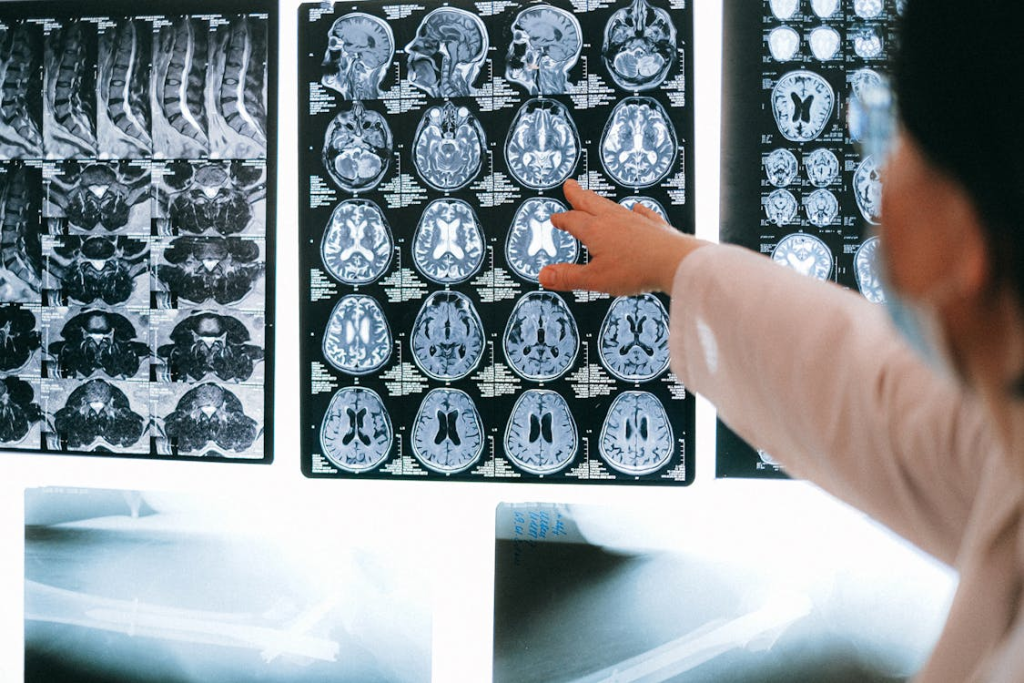Physical Health
What Is a Stroke? Types, Symptoms, Causes, Risk Factors, Treatment & Prevention

A stroke is a medical emergency that occurs when the blood supply to a part of the brain is suddenly interrupted or severely reduced. Without oxygen-rich blood, brain cells begin to die within minutes — making stroke one of the leading causes of death and long-term disability worldwide.
Understanding what a stroke is, the different types, early warning signs, causes, and preventive strategies can save lives — including your own.
🧠 What Exactly Is a Stroke?
A stroke happens when blood flow to a part of your brain is cut off, either due to a blockage (like a clot) or a ruptured blood vessel. This disruption prevents oxygen and nutrients from reaching brain tissue, causing cells to die rapidly.
Every second counts. Quick treatment minimizes brain damage and increases the chances of recovery.
⚠️ Common Symptoms of a Stroke (FAST Warning Signs)
The acronym F.A.S.T. can help you recognize the signs of a stroke quickly:
- F – Face drooping: One side of the face looks uneven or numb
- A – Arm weakness: Inability to lift both arms evenly
- S – Speech difficulty: Slurred speech or trouble speaking clearly
- T – Time to call emergency services: Immediate medical attention is critical
Other symptoms may include:
- Sudden numbness or weakness (especially on one side of the body)
- Confusion or trouble understanding speech
- Difficulty seeing in one or both eyes
- Dizziness, loss of balance, or coordination issues
- Severe headache with no known cause
Don’t wait. Stroke is a time-sensitive emergency. The faster the response, the better the outcome.
🔍 Types of Stroke You Should Know
Understanding the different types of stroke is essential for proper diagnosis and treatment:
🧩 1. Ischemic Stroke
- Cause: Blocked artery (blood clot or narrowed blood vessel)
- Frequency: Most common type (approximately 87% of all strokes)
- Examples: Thrombotic stroke (clot forms in the brain), embolic stroke (clot travels from another part of the body)
💥 2. Hemorrhagic Stroke
- Cause: Ruptured blood vessel causing bleeding in the brain
- Risk Factors: High blood pressure, aneurysms, trauma
- Types: Intracerebral hemorrhage (within brain tissue) and subarachnoid hemorrhage (bleeding between brain and surrounding tissues)
⚠️ 3. Transient Ischemic Attack (TIA)
- Often called a “mini-stroke”
- Temporary blockage with no permanent damage
- Warning sign: A major stroke could follow — take it seriously
🧬 What Causes a Stroke?
Stroke can result from several factors and underlying conditions, including:
- High blood pressure (Hypertension) – #1 cause of strokes
- Atherosclerosis – Plaque buildup in arteries
- Blood clots or heart conditions (like atrial fibrillation)
- Brain aneurysms or arteriovenous malformations (AVMs)
- High cholesterol and diabetes
- Head injuries (in hemorrhagic stroke cases)
🔎 Key Risk Factors for Stroke
While some risk factors are beyond your control, many are modifiable with lifestyle changes.
🧓 Non-Modifiable Risk Factors:
- Age (risk increases after 55)
- Gender (men have a higher risk, but women are more likely to die from stroke)
- Family history of stroke
- Prior stroke or TIA
🏃♂️ Modifiable Risk Factors:
- High blood pressure
- Smoking and alcohol use
- Poor diet (especially high in salt and sugar)
- Physical inactivity
- Obesity
- Diabetes
- High cholesterol
- Stress and unmanaged mental health
🧪 How Stroke Is Diagnosed
If a stroke is suspected, medical professionals will perform a combination of:
- Neurological exams
- Brain imaging (CT scan or MRI)
- Blood tests
- Electrocardiogram (EKG) to check for heart conditions
- Carotid ultrasound or angiography to examine blood flow
Early diagnosis can determine the type of stroke and guide treatment decisions.
💉 Stroke Treatment: Time Is Brain
🧊 Emergency Treatment for Ischemic Stroke:
- Clot-busting drugs (tPA): Must be administered within 3–4.5 hours of symptom onset
- Mechanical thrombectomy: Removing the clot manually (for large clots)
🩸 Emergency Treatment for Hemorrhagic Stroke:
- Blood pressure control
- Surgical repair of blood vessels
- Draining accumulated blood to relieve pressure on the brain
🧠 Post-Stroke Recovery:
- Physical therapy
- Occupational therapy
- Speech therapy
- Psychological counseling for mental and emotional support
🛡️ How to Prevent a Stroke
Fortunately, up to 80% of strokes are preventable with proactive lifestyle changes and medical management.
✅ Prevention Tips:
- Keep blood pressure under control (target: <120/80 mm Hg)
- Quit smoking immediately
- Limit alcohol and processed foods
- Exercise regularly (at least 30 minutes, 5x/week)
- Manage diabetes and cholesterol
- Eat a brain-friendly diet: Leafy greens, berries, omega-3s
- Stay mentally and emotionally balanced (chronic stress increases stroke risk)
🧠 “Prevention is the most powerful treatment,” says Dr. Linda Meyer, stroke specialist.
📊 Stroke Quick Facts
| Category | Statistic |
|---|---|
| Leading cause of death | #5 in the U.S. |
| Every year | ~800,000 people suffer a stroke |
| Most common type | Ischemic (87%) |
| Women vs. Men | Women more likely to die from stroke |
| Preventability | 80% of strokes are preventable |
🧠 Final Thoughts: Know the Signs. Protect Your Brain.
A stroke can change your life in seconds — but awareness and quick action can change the outcome. Whether you’re caring for aging parents, managing your own health, or simply want to stay informed, knowing what a stroke is and how to prevent it is essential.
Act FAST. Live smart. And never ignore the signs.
More about stroke from YouTube channel Mass General Brigham
Physical Health
6 Everyday Habits That Can Weaken Your Pelvic Floor Health And What to Do Instead

Your pelvic floor is a crucial but often overlooked part of your core. This group of muscles supports your bladder, bowels, and reproductive organs. When working properly, the pelvic floor plays a big role in bladder control, posture, sexual function, and even stability.
But did you know that some small, everyday habits could be silently weakening your pelvic floor over time?
Pelvic floor therapists often see patients struggling with pelvic pain, urinary leakage, or pressure—not from injury, but from things they do every day without realizing the harm.
Below are 6 common habits that can put your pelvic floor at risk—and what to do instead to keep those muscles strong and healthy.
1. Holding In Your Pee Too Long
It may seem harmless to delay a trip to the bathroom, but regularly holding your urine for extended periods can lead to an overstretched bladder and weaken your pelvic floor muscles.
What to do instead:
Use the restroom when you feel the urge—but not every time you “might” need to go. Avoid making your bladder wait too long or too often.
2. Peeing “Just in Case” All the Time
On the flip side, constantly going to the bathroom “just in case” can actually train your bladder to send early signals—even when it’s not full. Over time, this can create urgency issues.
What to do instead:
Stick to urinating every 2 to 4 hours and respond to natural cues—not out of habit or anxiety.
3. Straining During Bowel Movements
Pushing or straining during constipation increases abdominal pressure, which transfers directly onto your pelvic floor. Over time, this can cause prolapse or muscle fatigue.
What to do instead:
Support healthy bowel movements by drinking plenty of water, eating fiber-rich foods, and using a footstool to raise your knees into a squat-like position.
4. Overdoing Kegel Exercises
Yes, Kegels can help strengthen the pelvic floor—but doing them too often or without proper guidance can backfire, causing muscle tension or imbalance.
What to do instead:
Focus on both contracting and relaxing the pelvic floor. A balanced approach is key. If unsure, consult a pelvic floor physical therapist for a customized plan.
5. Sucking In Your Stomach All Day
Many people constantly “hold in” their belly to look slimmer, but doing this long-term can disrupt normal breathing and place pressure on the pelvic floor.
What to do instead:
Allow your abdomen to expand naturally when breathing. Engage your core only when needed—for example, during lifting or workouts.
6. Ignoring Pain During Sex or Exercise
Discomfort during intercourse or certain exercises might indicate pelvic floor dysfunction. Ignoring these signs could lead to more serious issues over time.
What to do instead:
Talk to your doctor or a pelvic floor specialist if you experience pain. Addressing early symptoms helps prevent long-term damage or dysfunction.
🧠 Why Pelvic Floor Health Matters
A weak or overactive pelvic floor can lead to a host of problems including:
- Urinary leakage
- Constipation
- Pelvic organ prolapse
- Lower back pain
- Pain during sex
Maintaining good habits, listening to your body, and getting professional help when needed can make a huge difference in your core and overall well-being.
✅ Final Thoughts
Most of us don’t think twice about our pelvic floor until something goes wrong. But by avoiding these six everyday habits—and replacing them with smarter strategies—you can keep your pelvic floor strong, balanced, and healthy.
If you’re experiencing ongoing pelvic issues, don’t hesitate to seek guidance from a pelvic floor therapist. They can assess your needs and build a recovery plan that’s specific to your body.
📌 Related Posts
- 6 Quick Morning Exercises to Burn Belly Fat All Day
- How to Boost Immunity Naturally: 10 Tips to Execute This
Understanding Pelvic Floor Conditions from Youtube
Physical Health
Isometric Exercises: A Proven Method to Lower Blood Pressure Naturally

High blood pressure, or hypertension, affects millions worldwide and is a leading risk factor for heart disease and stroke. While medications are commonly prescribed, recent studies highlight the significant impact of isometric exercises in naturally reducing blood pressure levels.
🧠 What Are Isometric Exercises?
Isometric exercises involve muscle contractions without joint movement. Unlike dynamic exercises, these workouts require holding a static position, engaging muscles continuously. Common examples include:
- Wall sits: Sitting against a wall with knees at a 90-degree angle.
- Planks: Holding the body in a straight line, supported by forearms and toes.
- Static lunges: Holding a lunge position without movement.
- Isometric handgrip exercises: Squeezing a device or object without changing hand position.
📊 Scientific Evidence Supporting Isometric Exercises
A comprehensive review published in the British Journal of Sports Medicine analyzed data from 270 randomized controlled trials involving over 15,000 participants. The findings revealed that:
- Isometric exercises led to an average reduction of 8.24 mm Hg in systolic and 4.00 mm Hg in diastolic blood pressure.
- These reductions were more significant compared to those achieved through aerobic, dynamic resistance, or high-intensity interval training (HIIT) exercises.
“Isometric exercises, such as wall sits and planks, are highly effective in lowering blood pressure and should be considered as a primary exercise modality for managing hypertension.” — British Journal of Sports Medicine
💪 Seated Isometric Exercises You Can Do at Home
✋ 1. Hand Grip Squeeze
This simple exercise can be done with a hand gripper, stress ball, or even a tennis ball — anything that provides resistance when squeezed.
🗣️ “Hold each squeeze for about 2 minutes per hand, then rest for 1 to 4 minutes before repeating,” recommends Ben Kelly, a cardiac health expert.
How to do it:
- Sit upright in a chair.
- Grip your resistance object tightly.
- Squeeze and hold for 2 minutes.
- Repeat 4 times per hand.
Muscles worked: Forearms, wrists, and hand flexors.
🏋️♀️ 2. Static Bicep Curl (Seated or Standing)
You can perform this movement while sitting or standing. Use light dumbbells, water bottles, or any object with weight.
How to do it:
- Hold a weight in each hand.
- Keep your elbows close to your sides.
- Bend your arms at 90 degrees, palms facing upward.
- Hold the position for 30–60 seconds.
Muscles worked: Biceps, forearms, and shoulders.
🦸 3. Superman Hold (Lying Position)
Although not technically seated, the Superman hold is a floor-based isometric exercise that doesn’t require standing — and it’s great for your core and back.
How to do it:
- Lie face down on a yoga mat or bed.
- Extend your arms forward and legs back.
- Simultaneously lift your chest, arms, and legs off the floor.
- Hold this flying pose for 30–45 seconds.
Muscles worked: Lower back, glutes, shoulders, and abdominals.
🚶 Standing Isometric Exercises for Lowering Blood Pressure
🧱 4. Wall Sit
The wall sit is a classic isometric move that challenges the lower body and has been shown to significantly reduce blood pressure when practiced regularly.
How to do it:
- Stand with your back against a flat wall.
- Slide down until your knees are at a 90° angle.
- Keep your back flat against the wall, and thighs parallel to the ground.
- Hold for up to 60 seconds without moving.
Advanced tip: Alternate lifting one foot at a time to increase intensity.
Muscles worked: Quadriceps, hamstrings, glutes.
🧘♀️ 5. Glute Bridge Hold
This back-lying exercise focuses on your posterior chain and strengthens your hips and core, while engaging stabilizer muscles that support the spine.
How to do it:
- Lie on your back with knees bent, feet flat on the ground.
- Press through your heels to lift your hips.
- Keep your body in a straight line from shoulders to knees.
- Hold the bridge for 30–60 seconds.
Advanced tip: Place a weight on your hips for increased resistance.
Muscles worked: Glutes, hamstrings, lower back, core.
🧪 Isometric Exercises vs. Other Workouts for Blood Pressure
A landmark systematic review analyzed over 270 clinical trials and compared five main categories of exercise for their impact on resting blood pressure:
Exercise Type Average Effectiveness ✅ Isometric Exercise Most effective ✅ Combined Training (Cardio + Weights) Highly effective ✅ Resistance Training Effective ✅ Aerobic Exercise Moderately effective ✅ HIIT (High-Intensity Intervals) Effective but variable
📊 Isometric exercises came out on top, outperforming cardio, HIIT, and resistance workouts when it came to lowering both systolic and diastolic blood pressure.
This means that even short, static holds — when performed consistently — may provide greater benefits than a 30-minute jog.
🏋️♀️ How Do Isometric Exercises Lower Blood Pressure?
The mechanisms by which isometric exercises reduce blood pressure include:
- Improved vascular function: Enhancing the elasticity of blood vessels, leading to better blood flow.
- Reduced arterial stiffness: Decreasing resistance in the arteries, facilitating easier blood circulation.
- Enhanced autonomic regulation: Balancing the nervous system’s control over heart rate and blood pressure.

🕒 Incorporating Isometric Exercises into Your Routine
To effectively lower blood pressure through isometric exercises:
- Frequency: Aim for 3 sessions per week.
- Duration: Each session should include 4 sets of 2-minute holds, with 1-2 minutes of rest between sets.
- Progression: Gradually increase the duration and intensity as your strength improves.
Sample Routine:
- Wall Sit: 2 minutes hold
- Rest: 2 minutes
- Plank: 2 minutes hold
- Rest: 2 minutes
- Repeat the cycle
Note: Always consult with a healthcare professional before starting any new exercise regimen, especially if you have existing health conditions.
🧘♂️ Additional Benefits of Isometric Exercises
Beyond lowering blood pressure, isometric exercises offer:
- Improved muscular strength and endurance
- Enhanced core stability
- Better posture and balance
- Convenience: No equipment needed and can be performed anywhere
🏃 Can Other Exercises Help Lower Blood Pressure?
Yes! The NHS and other health organizations continue to recommend aerobic exercises like brisk walking, cycling, or swimming as part of a well-rounded plan for managing hypertension.
NHS Activity Guidelines:
- 150 minutes per week of moderate-intensity aerobic activity
- Spread across 4–5 days
- Combine with strength training for added benefit
However, adding isometric exercises like wall sits or handgrip squeezes can provide an additional layer of protection, especially for those unable to engage in high-impact or extended workouts.
📝 Final Thoughts
Incorporating isometric exercises into your fitness routine is a simple yet effective strategy to manage and reduce high blood pressure. With consistent practice, these exercises can lead to significant health improvements, complementing other lifestyle modifications.
📌 Related Articles
- The Power of HIIT Workout: Ultimate Efficiency and Fitness Transformation
- Benefits of Outdoor Exercise: Fit with Nature
- Best Yoga for Strength and Flexibility: Full Body Practice at Home
Ready to take control of your blood pressure? Start incorporating isometric exercises today and experience the benefits firsthand.
Physical Health
Why the Rise in Heart Attacks among Young Adults
While heart attacks are commonly connected with older people, it’s crucial to recognize that young adults can likewise encounter this life-threatening event. The symptoms in younger people may not always align with the classic signs observed in older populations.

In an age where youth is frequently compared with health and vitality, the unexpected reality of a surge in heart attacks among young adults stands as a stark and concerning paradox. Generally, heart attacks or coronary failures were seen as a danger to an older demographic, but statistics have shown a disrupting reality—more young adults are presently finding themselves in the trauma center because of heart events.
Now, we’ll investigate the huge number of factors contributing to this troubling pattern and how people, medical experts, and society at large can respond to it.
Table of Contents
What is Heart Attack
A heart attack, also known as myocardial infarction, occurs when oxygen to the heart muscle is seriously diminished or cut off totally, frequently by a blocked artery. Arteries can be blocked or narrowed due to fat, cholesterol, and different substances that together are called plaque. Since the coronary desires oxygen to survive, the coronary heart muscle that has misplaced its blood deliver begins to struggle. How much harm to the heart depends upon the size of the area impacted by the blocked artery and how much time passes between the heart attack and treatment.
Common signs and symptoms consist of chest pain, shortness of breath, and pain within-side the top body.
Risk factors include age, family ancestry, smoking, high blood pressure, and high cholesterol. Lifestyle changes, medications, and medical procedures can manage and reduce the risk of heart attacks. Understanding the signs and looking for guaranteed clinical assistance is significant for improved results in heart attack cases.
Heart attack increased in young adults after COVID-19 pandemic
Factors of Heart Attacks among Young Adults
The modern lifestyle, characterized by its propensities towards sedentary habits, regular guilty pleasures in calorie-dense but nutrient-poor foods, and a mounting burden of stress, is taking a heavy toll on our cardiovascular health. These factors, which were once to a great extent connected with the older population, are now infiltrating the lives of young adults with an alarming impact on their heart health.
1. Sedentary Lifestyle
The seductive screens of our daily devices and the solace of the inside have significantly reduced physical activity levels among young adults. Activity that was once essential for daily life, such as walking to school or labor-intensive chores, has been largely replaced by prolonged periods of sitting. The implications of this extreme lifestyle shift are far-reaching, with a sedentary lifestyle emerging as a significant risk factor for heart attacks in the youthful.
2. Poor Dietary Habits
The multiplication of fast food, sweetened beverages, and processed snacks has prompted to change in dietary standards. Young adults, specifically, are helpless against taking on these unhealthy dietary patterns, often for the sake of convenience or due to a lack of information about proper nutrition.
The dangerous combination of elevated cholesterol, hypertension, and obesity, which frequently result from such eating patterns, lays the groundwork for the premature occurrence of heart attacks.
3. Stress and Mental Health Issues
The rising pervasiveness of mental health conditions, like anxiety and depression, is firmly interlaced with the expanded stress levels faced by youthful grown-ups today. Pressures in academia, burgeoning workloads, and the ceaseless hum of social media have created a climate ready for chronic stress, a known impetus for heart disease. It is becoming apparent that the mental health of young adults is as basic to their heart health as their physical wellbeing.
The Impact of Heart Attacks on Young Lives
The physical and emotional toll of a heart attack on a young adult can be devastating. The tragic loss of life aside, survivors are frequently confronted with a compromised quality of life and an unfathomable burden of managing a chronic disease at an age when they least expected it.
Beyond the individual level, the financial implications are significant, as the loss of a young, productive member of society has far-reaching consequences for families and communities.
1. Health Consequences
Surviving a heart attack imposes long-term implications on a young adult’s health. Issues such as reduced heart function, ongoing medication needs, and the need for interventions like stents or bypass surgeries can significantly hinder the individual’s ability to resume a normal, active life. It’s not just a one-time event; a heart attack can represent the beginning of a lifelong battle with heart disease.
2. Economic Implications
The financial strain on both the impacted individual and the medical care framework is impressive. Medical bills, the cost of ongoing treatment and medication, as well as expected loss of income if the young adult can’t get back to their pre-attack level of employment, make a complex economic challenge. Besides, the increased burden on an all-around overextended system brings up alarming issues about its long-term sustainability.
Proactive Measures: Protecting Your Heart in Youth
The occurrence of heart attacks among the young isn’t a certainty, but rather a conversion of preventable issues. Engaging in regular physical activity, embracing a reasonable and heart-healthy diet, and developing skills to manage and alleviate stress are powerful tools for strengthening heart health.
1. Importance of Regular Exercise
Physical activity remains a principal mainstay of cardiovascular well-being. Regular exercise not only strengthens the heart muscle but also assists in managing weight, blood pressure, and cholesterol levels. It’s crucial for young adults to of stationary living and incorporate development into their daily schedules.
2. Balanced Diet for a Strong Heart
Nutrition plays an essential part in forestalling coronary attacks. A diet rich in fruits, vegetables, whole grains, and lean proteins can essentially decrease the risk of heart disease. Young adults should strive to develop healthy eating habits early on to protect their cardiovascular system.
3. Stress Management Techniques
Effective stress management techniques can assist young adults with appropriating the perilous impacts of chronic stress on their hearts. Engaging in mindfulness practices, seeking therapy when necessary, and developing healthy coping mechanisms are fundamental parts of keeping up with one’s psychological well-being and, by extension, heart health.
Awareness and Education: The Keys to Prevention
Raising awareness about the danger factors for heart attacks among young adults, as well as teaching people on the steps they can take to limit those dangers, is a basic starting point in combating this upward trend. Public health campaigns, school educational programs that stress health and wellbeing, and the direction of medical services suppliers play a crucial part to play in dispersing this life-saving data.
1. Campaigns and Initiatives
Health organizations and public health bodies can initiate targeted campaigns to inform young adults about the risk factors for heart attacks. These efforts can leverage digital media and community events to reach a wide audience, highlighting the importance of proactive heart health management.
2. Role of Healthcare Providers
Medical professionals many times the primary resource for young adults in the healthcare system. Empowering them with the most recent data and tools to direct their patients on coronary disease prevention can have a significant effect.
Standard check-ups ought to reach out to past physical assessments to include conversations about lifestyle decisions and implications for heart health.
Conclusion: A Self-Check on Lifestyle and Regular Check-Ups
The rise in heart attacks among young adults is a mind-boggling issue that requires a diverse reaction. People, healthcare providers, and society the same should perceive the gravity of this pattern and take decisive actions to switch it.
Engaging in regular exercise, consuming a heart-healthy diet, and managing stress effectively are goals that require dedication and a long-term perspective.
However, the investment in these lifestyle changes is minor contrasted with the profits of a daily existence liberated from the shadow of coronary disease.
By committing to proactive habits and regular health check-ups, young adults can essentially decrease their risk of experiencing a heart attack, and society can move one stage closer to ensuring a healthier future for its youth.
Related Video
1. Top 10 Warning Signs Of Silent Heart Attack You Should Not Ignore
2. Gravitas: 10 heart attacks in 24 hours: Why are India’s young dying of heart attacks?
FAQs on Heart Attacks among Young Adults
What are the symptoms of a heart attack in young adults?
While heart attacks are commonly connected with older people, it’s crucial to recognize that young adults can likewise encounter this life-threatening event. The symptoms in younger people may not always align with the classic signs observed in older populations.
Young adults might experience chest pain, however it very well may be less articulated or missing. Instead, symptoms like shortness of breath, fatigue, nausea, or discomfort in the arms, neck, jaw, or back might be more common. Because of the abnormal show, there’s a gamble of confounding these signs or crediting them to different causes. Quick clinical consideration is fundamental if youthful grown-ups experience surprising distress, as brief mediation can essentially affect results. Attention to abnormal side effects is vital to guaranteeing that youthful grown-ups get convenient and proper consideration, possibly saving lives and limiting the drawn-out impact on heart health.
Does Covid-19 increase risk of heart attack?
The connection between COVID-19 and an expanded risk of coronary attack has gathered consideration within the medical community. While a respiratory sickness, Coronavirus can influence the cardiovascular framework, possibly hoisting the gamble of heart-related confusion. The infection might prompt aggravation, blood cluster development, and weight on the heart. People with previous cardiovascular circumstances are especially helpless. The disease’s seriousness and the body’s incendiary reaction add to a higher probability of unfriendly cardiovascular occasions, including respiratory failures. Observing side effects, particularly chest torment, windedness, or diligent weariness, is vital for those recuperating from Coronavirus. Looking for brief clinical consideration for any unsettling signs is vital for addressing expected cardiovascular inconveniences and guarantee far-reaching care during the recuperation interaction.
What lifestyle changes can prevent heart attacks in young adults?
Preventing heart attacks in young adults involves adopting heart-healthy lifestyle changes. Regular exercise is crucial, enhancing cardiovascular health and managing weight. A balanced diet, rich in fruits, vegetables, whole grains, and lean proteins, helps control cholesterol and blood pressure. Avoiding tobacco and limiting alcohol intake are essential. Stress management through techniques like meditation and adequate sleep contributes to overall well-being. Routine health check-ups can catch risk factors early. Maintaining a healthy lifestyle, particularly for those with a family history of heart disease, diabetes, or obesity, is pivotal. Awareness, coupled with proactive measures, empowers young adults to safeguard their heart health, minimizing the risk of heart attacks and fostering a long and healthy life.
How can improve heart health?
Improving heart health involves adopting a comprehensive approach that encompasses lifestyle modifications and preventive measures. Regular exercise is fundamental, promoting cardiovascular fitness and reducing the risk of heart disease. A balanced diet rich in fruits, vegetables, whole grains, and lean proteins supports heart health by managing cholesterol levels and blood pressure. Avoiding tobacco and limiting alcohol intake are crucial lifestyle choices. Effective stress management through techniques like meditation and adequate sleep contributes to overall well-being. Regular health check-ups help monitor heart health and detect potential issues early. By incorporating these habits into daily life, individuals can significantly enhance their heart health, reduce the risk of heart-related conditions, and foster a long and healthy life.
What can I do to recover after a heart attack?
After a heart attack, recovery is crucial to prevent further health issues. Damage to the heart can impact its rhythm and pumping ability, increasing the risk of stroke, kidney disorders, and peripheral arterial disease. To lower these risks, consult your healthcare team about adjusting daily activities and potentially limiting strenuous tasks. Embrace lifestyle changes, including a healthier diet, increased physical activity, smoking cessation, and stress management. Cardiac rehabilitation is a valuable resource, offering supervised programs covering physical activity, education on healthy living, and counseling to address stress and mental health. This comprehensive approach, guided by healthcare professionals, helps improve heart health and overall well-being after a heart attack.
-

 Personal Care8 months ago
Personal Care8 months agoWhy Regular Massages Could Be the Game-Changer Your Body and Mind Crave
-

 Mental Health7 months ago
Mental Health7 months agoHow to Overcome Phobias: 15 Positive Psychology-Based Strategies That Really Work
-

 Lifestyle7 months ago
Lifestyle7 months agoWhen Is It Time To Get a Divorce? Emotional, Mental & Practical Signs to Know
-

 Fitness7 months ago
Fitness7 months ago6 Quick Morning Exercises to Burn Belly Fat All Day
-

 Mental Health7 months ago
Mental Health7 months agoWhat Is A Depression Attack? Symptoms, Causes & How To Cope With One
-

 Lifestyle7 months ago
Lifestyle7 months agoHow to Improve Egg Quality for Fertility: Science, Lifestyle and Expert Tips
-

 Food7 months ago
Food7 months agoHealthy Rice Varieties: Nutrition and Health Benefits
-

 Personal Care7 months ago
Personal Care7 months agoHow to Reparent Your Inner Child: Healing and Self-Compassion

